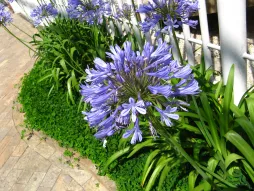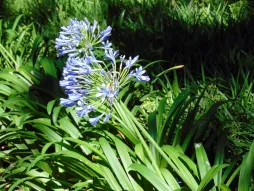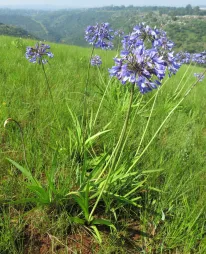Hippeastrum papilio, butterfly amaryllis
Hippeastrum papilio is often sold under the name Amaryllis. But, unlike its cousin amaryllis belladonna, this flowering plant is not native to South Africa, but to southern Brazil.
How to recognize Hippeastrum papilio amaryllis?
Hippeastrum papilio is an upright perennial. It measures 60 centimetres in height with a 20-centimetre spread.
The rounded, brown bulb reaches a diameter of twelve centimetres. It gives rise to a green, round, hollow stem.
The narrow, green, ribboned leaves are evergreen. Although the old leaves dry up in summer, they are quickly replaced by new ones. Initially upright, these leaves take on an arched shape when mature.
Each bulb can produce two to three flower stalks, bearing up to four flowers. The tapering, greenish-white petals are streaked with red and burgundy. They bloom in winter. For some, their shape is reminiscent of orchids or butterflies.
After flowering, the plant forms a dehiscing capsule containing numerous seeds. However, pollination indoors is rare, and it's uncommon to see butterfly amaryllis fruiting outside its natural habitat.
Warning: like all plants in the Amaryllidaceae family, Hippeastrum papilio is toxic if ingested, especially by pets. It is therefore essential to keep it out of the reach of your four-legged companions.
Our maintenance tips
For your Amaryllis butterfly to flourish, you need to respect its natural rhythm and dormant phase.
Watering
Adapt watering during the growing season.
Allow the rootball to dry out to one centimeter between waterings. Water generously with non-calcareous water (rainwater, for example) at room temperature.
Drain off any excess water left in the dish or planter. It can rot the roots.
During the rest of the year, adjust the watering frequency of your Hippeastrum papilio.
Once flowers and leaves have faded, reduce watering. Water sparingly to prevent the soil from drying out completely.
Repotting
Obtain a perforated pot at least 25 centimetres in diameter and a well-draining substrate. You can mix potting soil for green plants andsand, for example.
Plant your hippeastrum papilio in the center. The bulb should not touch the sides and its tip should point upwards. Add potting soil without covering the bulb completely. It should only be half-buried.
Water lightly for the first time to help the bulb take root.
Fertilization
Apply fertilizer to stimulate growth.
Applying indoor plant fertilizer helps your Amaryllis butterfly to grow.
Apply fertilizer to encourage growth.
Applying indoor plant fertilizer helps your Amaryllis butterfly to grow.
Cleaning
Clean the leaves with a clean wet sponge. This removes dust and improves photosynthesis. It's also a way of preventing mite infestations.
Prune
When the flower fades, prune the flowering stem flush with the foliage.
Do not touch the leaves while they are green. The plant needs them to replenish its reserves. When they are completely dry, you can remove them.
Cutting
Dig up your Hippeastrum papilio to separate the bulbs from the mother plant. Using your hands or a clean, sharp tool such as a knife, cut off a bulb. Make sure it has roots and a portion of stem.
Prepare a perforated pot at least 25 centimetres in diameter. Fill it with a rich, well-draining substrate, such as a mixture of potting soil and sand.
Plant your hippeastrum papilio in the center. Cover with substrate, but allow the tip to protrude by about two to five centimetres.
Water lightly to promote contact between the bulb and the soil.
Information
| Family | Amaryllidaceae - Amaryllidaceae |
| Type | Hippeastrum - Hippeastrum |
| Species | Amaryllis butterfly - Hippeastrum papilio |
| Lifecycle | Perennial |
| Foliage | Evergreen |
| Substrats | |
| Planting methods |
Open ground In pots In tubs |
| Categories | |
| Tags |
Flowery Toxic |
| Origin |
South America |
| Hardiness (USDA) | 10b |
| Leaf color |
|
| Flower colors |
|
Discover plants from the same family

Florist's amaryllis
Discover

Agapanthus africanus
Discover

Early Agapanthus
Discover

Agapanthus campanulatus
Discover
















